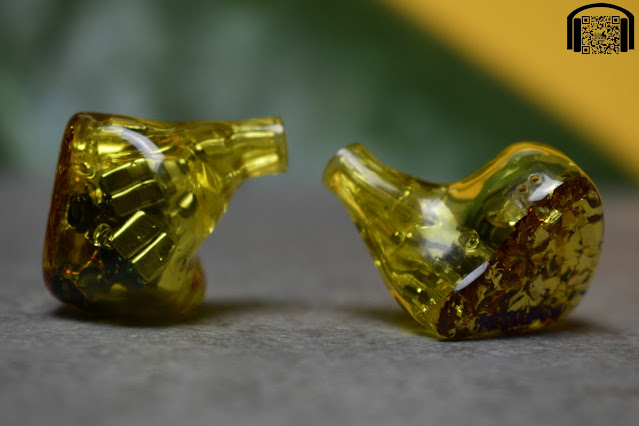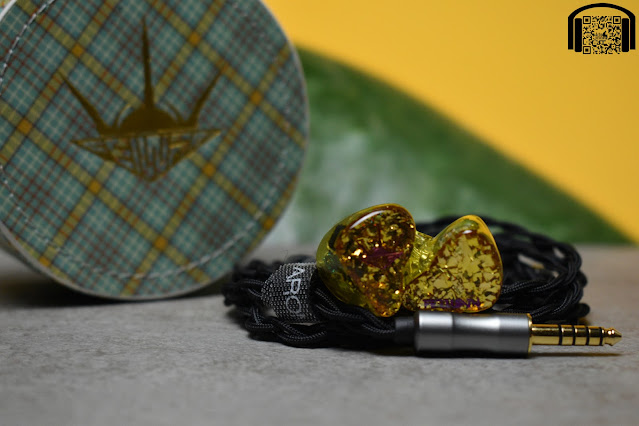- Get link
- X
- Other Apps
English | Español
TLDR version on YouTube: TDLR - Aroma Audio FEI WAN
The Aroma FEI WAN have been sent to me as part of a tour, for me to test them out and to share my opinions. I have not actually had any contact with Aroma Audio as I was very kindly included in the tour by a fellow IEM lover. Therefore, it goes without saying that I have not received any comments or requests from Aroma Audio (or anyone else) and my opinions are based on me being as sincere and unbiased as humanly possible.
The official page for the Aroma FEI WAN can be found here: https://www.aromaaudio.com.hk/aroma-fei-wan.html
As with all the links I post, this is a non-affiliate link.
To avoid being repetetive in my reviews, you can find all the info about how I create the reviews, equipment used, how I receive the products and how to interpret my reviews by visiting: About my reviews
Intro…
Aroma Audio are a company that is firmly planted in the high end IEM segment. Although they do produce a DAC, an amplifier and a couple of other accessories, they are know for their IEMs, both universal and custom, ranging from the Star, which comes in at just over 200€, up to the Jewel, which is priced at just over 5000€. Out of the 13 models they currently have on their site, only 4 of these are less than 4 digit prices, so we are obviously not talking about a budget brand.
The FEI WAN I believe is their latest release and is priced around 4500€, making it probably the most expensive set of IEMs I have reviewed to date. Featuring 2x 9.2mm dynamic drivers, together with 10x balanced armature drivers, it uses a patented technology that they call "Coaxial Strong Magnetic Pulse Pair Double Dynamic Drivers Technology", which, according to their site, involves reversing the magnetic polarity and coil polarity of one of the dynamic drivers.
That is a lot of drivers, a lot of jargon and even more euros, so let's see what makes the FEI WAN special.
Build and aesthetics…
I skipped presentation as this arrived in a small brown cardboard box with no product packaging (as this is a tour unit). It did come with a storage case but I am not sure if that is relevant to the actual retail packaging or not.
The IEMs shells are 3D printed in a translucent yellow, with a yellow/gold sparkle under the face plate that shows the logo on one IEM and the model on the other, both in purple.
I have to say that I am not a fan of the aesthetics of these IEMs. Obviously that is just a personal thing as beauty is in the eye of the beholder, but they wouldn't be my choice.
They are very light weight and the nozzles are rather long, with a curve to them. The nozzles are a little on the thicker side but not enough for me to have had any issues using normal tips of choice with them.
The nozzles also have a curve to them and, although the IEMs are by no means small, I have found them to be very comfortable. As soon as I put them in they felt at home and not fatigue built up over long (some very long) listening sessions.
The included cable is Aroma's own "Sparkle" cable, which retails on their site for over 500€. The cable is square core, silver plated oxygen free and Aroma say it makes the sound more "shiny". Now, you all know my opinions on cables, that if a cable is good, it is good regardless of price, but I wouldn't pick a cable to change the sound of my IEMs. In this case, the cable is one I am very fond of. It is a four core wrapped in fabric, yet it is not bulky and it is very soft to the touch, making it one of the nicest cables I have used. Metal hardware is present at both ends, although the two pin ends do have the plastic that is made for recessed connectors showing.
I understand that it is not possible to recess the connectors into the FEI WAN as it is rather crowded in there, and I applaud that they have included a nice cable, but for 4500€, it would have been nice for something to cover those plastic bits.
Sound…
All tracks mentioned are clickable links that allow you to open the reference track in the streaming service of your choice (YouTube, Tidal, Qobuz, Spotify, etc.)
So, the most important question of them all, how does the FEI WAN sound?
It sounds good. Very good!
I have spent my time with it listening to all kinds of music, from rock to rap, classical to pop, blues to reggae, and everything in between. It has done a great job with all the music I have thrown at it.
There have been a few occasions when things have been a little harsh but I think it is due to it revealing issues with the recordings more than any inherent issues of the IEMs itself.
But rather than just saying it sounds good, I will do my usual run through my test track list and give my comments on the performance in relation to the specific tracks.
First off, here is the graph in relation to my usual preference target:
Now this is one of those occasions when I was surprised to see the graph of the IEMs as I really don’t find that they sound like they graph. Of course, this can be me hearing what I want to hear, unconscious biases and all that, but I would never have guessed the FR based on what I had been hearing for 5 or 6 days before I measured them.
The subbass is deep and present yet very clean and controlled, in fact the whole bass area is, something that I find particularly impressive in the midbass section. Using my usual “Chameleon” as a test of the subbass, there is a deep and rumbling presence, yet the sensation is more of a clean subbass note than it is of a rumbling presence.
“Royals” has very defined subbass, with that grit that is part of the subbass on this track being quite apparent yet not dominant. I even ran some tests with a couple of bass drops that I don’t have on my usual test track list and the FEI WAN never seemed to lose control.
I just said that I am particularly impressed by the midbass, especially after seeing the graph. I did notice a little elevation in the midbass area but I would never have guessed that it would roll over into the lower mids. The sensation is not of bass bleed, rather of a very clean and precise midbass, with fast bass notes, such as in a lot of Victor Wootens music, being easily appreciated, note by note, without the sensation of loss of control.
My fatigue test of midbass, “Crazy”, does show that the midbass is there but it does not take over the sound signature and gives a lovely warmth to the guitar without becoming fatiguing at all. In fact, going through my test list, from EDM to acoustic, I never had the sensation that the midbass was anything less than great. That is not something I would have expected had I seen the graph first.
As we move through the mids and into the upper mids, again, the graph would lead me to expect a very low frequency focus with a lack of presence, yet, again, that is not the sensation that I get.
I am not sure if it is due to the quality of the drivers being used but the mid range, even the upper mids, do not give me a sensation of being recessed or lacking presence at all. Even with things like “Bury A Friend”, where there is a lot of low end presence to overcome, Biliie’s vocals are still clear and present.
Listening to “Bombtrack”, I found that maybe here the vocals could seem a little further back but I think that is mainly due to the fact that the FEI WAN present a very present an impressive lower range, with the drums, bass and guitar being felt more than heard.
The upper mids and lower treble being slightly reduced works very well for some of the harsher and more sibilant tracks, such as “Hope Is A Dangerous Thing”, where Lana Del Rey is not sibilant at all yet she does not lose presence. The same can be said for Zella Day in “Seven Nation Army”.
The details are very good yet the most impressive part to me is the placing of these details. There is a good sense of soundstage with all tracks, yet, when a track that has a lot of detail surrounding you, the sensation becomes excellent. I would say that, as far as image placement and sensation of layering, the FEI WAN are possibly the best IEMs I have heard to date.
For example “Strange Fruit” is a track that has plenty of layers and detail to the vocals but to really appreciate the complexity of what is going on, you need to hear it on something that really makes these layers shine. One of my favourite presentations of this song is with the Hifiman HE1000se and the Susvara, well, the FEI WAN create a sensation that is almost as good. That is a lot of praise!
Conclusion…
The FEI WAN are a set of IEMs that I don’t think I would have ever taken notice of if I had seen the graph (and the price) before listening to them. When I received them, I knew nothing about them and I think that has been responsible for most of the fun I have had with these IEMs.
They are a tuning that I would never have thought I would like but it just works together with the performance of these IEMs. There are certain tracks that I would prefer on other sets but in general, I can’t say that the FEI WAN haven’t impressed me every day I have spent with them.
I obviously can’t say that they are worth their price, as that is something that each person needs to decide for themselves when talking about this level of investment, but if you are in the market for a set of IEMs in this kind of price range, I think that the FEI WAN are something that you should really try to listen to if you can, as they are surprisingly different yet great at the same time.
All FR measurements of IEMs can be viewed and compared on achoreviews.squig.link
All isolation measurements of IEMs can be found on achoreviews.squig.link/isolation
To comment or contact, visit any of the following social media platforms:
- Get link
- X
- Other Apps






